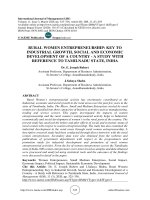Economic growth and economic development 665
Bạn đang xem bản rút gọn của tài liệu. Xem và tải ngay bản đầy đủ của tài liệu tại đây (93.2 KB, 1 trang )
Introduction to Modern Economic Growth
(2) Characterize the balanced economic growth path and specify restrictions
on parameters so that the transversality condition is satisfied.
(3) Why did we assume that the lower support of λ is (1 − β)−1 ? How would
the analysis change if this were relaxed?
(4) Show that there are no transitional dynamics in this economy.
(5) Compare the BGP growth rate to the Pareto optimal growth rate of the
economy. Can there be excessive innovations?
Exercise 14.14. In the model of Section 14.2 show that the economy experiences
no growth of output for intervals of average length 1/ηL∗R .
Exercise 14.15.
(1) Prove Proposition 14.4, in particular verifying that the
allocation described there is unique, that the average growth rate is given
by g ∗ = ln ληL∗R and that condition (14.27) is necessary and sufficient for
the existence of the equilibrium described in the proposition.
(2) Explain why the growth rate features ln λ rather than λ − 1 as in the model
of Section 14.1.
Exercise 14.16. Consider the one-sector Schumpeterian model in discrete time.
Suppose as in the model in Section 14.2 that consumers are risk neutral, there is no
population growth, and the final good sector has the production function given by
(14.25). Assume that the R&D technology is such that LR > 0 workers employed
in research will necessarily lead to an innovation, and the number of workers used
in research simply determines the quality of the innovation via the function λ (LR ),
which is strictly increasing, continuously differentiable, strictly concave and satisfies
the Inada conditions.
(1) Define an equilibrium in this economy.
(2) Characterize the BGP and specify restrictions on parameters so that the
transversality condition is satisfied.
(3) Compare the BGP growth rate to the Pareto optimal growth rate of the
economy. Show that the size of innovations is always too small relative to
the size of innovations in the Pareto optimal allocation.
Exercise 14.17. * Consider the one-sector Schumpeterian model in discrete time
analyzed in the previous exercise. Suppose that when a new innovation arrives a
651









